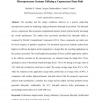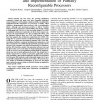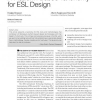DASIP
2010
14 years 9 days ago
2010
Nowadays, the design flow of complex signal processing embedded systems starts with a specification of the application by means of a large and sequential program (usually in C/C++...
VLSISP
2008
14 years 5 months ago
2008
The speedups and the energy reductions achieved in a generic single-chip microprocessor system by employing a high-performance data-path are presented. The data-path acts as a copr...
TVLSI
2008
2008
A Design Flow for Architecture Exploration and Implementation of Partially Reconfigurable Processors
14 years 5 months ago
During the last years, the growing application complexity, design, and mask costs have compelled embedded system designers to increasingly consider partially reconfigurable applica...
TC
2008
14 years 5 months ago
2008
Abstract-- Preventing silicon chips from negative, even disastrous thermal hazards has become increasingly challenging these days; considering thermal effects early in the design c...
DT
2006
14 years 5 months ago
2006
gn: abstraction and reuse. The authors present an ESL design flow using the Gezel language. Using several very different design examples, they this design flow supports their case ...
DT
2006
14 years 5 months ago
2006
the abstraction level at which designers express systems, enabling new levels of design reuse, and providing for design chain integration ool flows and abstraction levels. The purp...
CORR
2008
Springer
14 years 5 months ago
2008
Springer
This paper presents one MEMS design tool with total six design flows, which makes it possible that the MEMS designers are able to choose the most suitable design flow for their sp...
DAC
2005
ACM
14 years 7 months ago
2005
ACM
In this paper we discuss an efficient design flow from Matlab® to FPGA. Employing Matlab for algorithm research and as system level language allows efficient transition from algo...
CASES
2008
ACM
14 years 7 months ago
2008
ACM
Detailed or cycle-accurate/bit-accurate (CABA) simulation is a critical phase in the design flow of embedded systems. However, with increasing system complexity, full detailed sim...
ASPDAC
2008
ACM
14 years 7 months ago
2008
ACM
The quality of the input system model has a direct bearing on the effectiveness of the system exploration and synthesis tools. Given a well-structured system model, tools today are...



